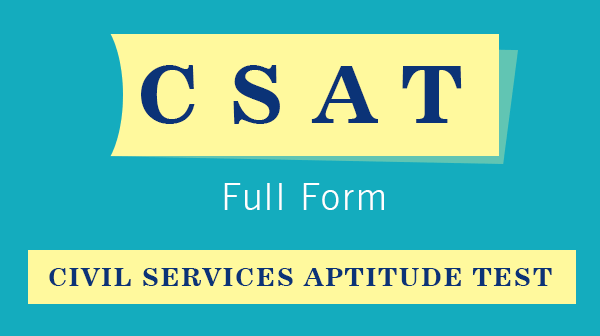What is the full form of CSATCSAT: Civil Services Aptitude TestCSAT stands for Civil Services Aptitude Test. It is a part of the Civil Services Exam. The Union Public Service Commission holds the Civil Services Examination (CSE), a national competitive exam, in India for the recruitment of higher civil services, such as the Indian Police Service, Indian Foreign Service, and Indian Administrative Service. 
UPSC examination is divided into three phases: a preliminary examination with two objective-type exams (General Studies Paper I and Civil Service Aptitude Test (CSAT), commonly known as General Studies Paper II, and the major test of nine traditional (essay)-style papers, of which only two are qualifying seven marks are counted. The final phase is a personality test (interview). A successful applicant must undergo 32 hours of testing which takes around a year. ProcessThe Civil Services Examination is modeled after imperial civil service exams from the British era as well as those administered by former Indian empires such as the Mauryan Empire and the Mughal Empire. One of the hardest competitive exams in India is this one. A single try may require two full years of preparation: one year prior to the preliminary exams and one year following the preliminary exams till the interview. Every year, between 900,000 and 1,000,000 people apply on average, and roughly 550,000 candidates take the preliminary exam. Mid-August marks the release of Preliminary Exam results, whereas May marks the release of Final Exam results. Selection Process
The training programme for the chosen candidates typically starts the following September when the physical examination of the successful applicants and other formalities are completed. EligibilityFollowing are the requirements for the exam: i) NationalityRegarding the Indian Foreign Service, Indian Police Service, and Indian Administrative Service. The applicant must be an Indian national. The applicant for other services must fit one of the following criteria:
ii) Educational backgroundAll applicants must possess at least one of the following academic credentials:
The following applicants are also qualified; however, they must present identification from a relevant institution/university official before the main exam to avoid failing.
iii) AgeThe applicant has to be at least 21 years old and, for general category candidates, not older than 32 years old on August 1 of the assessment year. With regard to caste reservations, different age restrictions apply.
Recent changes in Civil Services PreliminariesThe revised curriculum was launched in 2011. There are two papers: General Studies and Current Affairs in Paper IIt covers every subject from the former Paper I syllabus, with the exception of general mental aptitude. Additionally, it includes fresh subjects like social and economic growth as well as broader concerns with an environmental ecology, biodiversity, and climate change. General Mental Capacity Paper IIThe General Mental Ability section of the Civil Services Aptitude Test is now found in Paper II. This section was previously found in Paper I. As of late, it has expanded to comprehension understanding, interpersonal skills like comprehension, logical thinking and analytical skills, decision-making and problem-solving, basic arithmetic, data interpretation, and English language comprehension abilities. CSAT Exam PatternThere are a total of 400 marks available for the preliminary test, which comprises two objective-type examinations with multiple-choice questions. This test is only intended to be used as a screening tool. The final order of merit is determined without taking into account the preliminary examination scores. There are two 200-point mandatory papers. In Paper-I, there are 100 problems each of 2 marks, whereas, in Paper-II, there are 80 questions worth a total of 2.5 marks. For every question, there are four potential solutions. The question papers are written in both Hindi as well as English. The question paper does not provide any evidence of the Hindi translation for questions testing understanding of sections in English, nonetheless. CSAT Negatively MarkingAnswers that are erroneous receive a lower grade. One-third of the marks awarded for that question will be deducted if you select the incorrect response. Even if one of the several answers you provide turns out to be accurate, it is still considered a bad response if you provide more than one. There is no penalty for a question that is left unanswered or that is left blank.
Next TopicFull Form
|
 For Videos Join Our Youtube Channel: Join Now
For Videos Join Our Youtube Channel: Join Now
Feedback
- Send your Feedback to [email protected]
Help Others, Please Share










